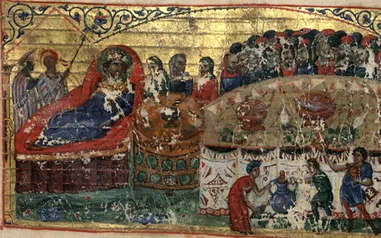Part IV: The New Testament in Koine Greek
The Language of the New Testament
Unlike the Hebrew Scriptures, which were written in ancient Hebrew and some portions in Aramaic, the New Testament was written in Koine Greek—the common language of the Eastern Mediterranean from the 4th century BCE to the 4th century CE. Koine Greek was a simplified and more accessible version of Classical Greek, the prestigious language of earlier Greek literature. It emerged after Alexander the Great’s conquests, which spread Greek influence across much of the known world. As a result, Greek became the lingua franca of the Eastern Mediterranean and beyond, facilitating communication among a diverse population of Jews, Greeks, Romans, and others in the Hellenistic world.
The use of Koine Greek for the New Testament was strategic. It enabled the teachings of Jesus and his apostles to be understood widely, even by people with varying linguistic backgrounds. Written primarily in the first century CE, the New Testament’s Greek text mirrored the vernacular of its time, making the Gospel message accessible to both Jews familiar with the Septuagint (Greek translation of the Hebrew Scriptures) and Gentiles outside of the Jewish faith. Koine Greek, used for business, governance, and daily communication, was ideal for the spread of the Christian message across the Roman Empire.
The Transmission of the Text
The New Testament has been remarkably well-preserved through thousands of manuscripts that date from the second century onward. There are more than 5,800 Greek manuscripts of the New Testament, ranging from small fragments to complete texts. The earliest of these fragments, such as Papyrus 52, which contains a portion of the Gospel of John (18:31-33), dates to around 125 CE. This fragment is considered one of the oldest surviving manuscripts of any part of the New Testament and provides crucial evidence of the early circulation of Christian texts.
As Christianity spread throughout the Roman Empire, so too did the manuscripts. The texts were copied by hand, a painstaking and precise process that continued for centuries. While no original autographs (the actual writings of the apostles and their associates) have survived, these manuscripts provide a wealth of evidence about the early text of the New Testament.
One of the most important early manuscripts is the Codex Sinaiticus, discovered in 1844 by Constantin von Tischendorf at the Monastery of St. Catherine at Mount Sinai. Dating to the 4th century, Codex Sinaiticus contains a nearly complete New Testament along with much of the Old Testament in Greek. Another important manuscript is the Codex Vaticanus, also from the 4th century, which is housed in the Vatican Library and provides another early version of the entire Bible. These manuscripts, along with others such as the Codex Alexandrinus and Codex Ephraemi Rescriptus, form the backbone of our understanding of the early New Testament text.
The Importance of Early Versions
In addition to Greek manuscripts, several ancient versions of the New Testament in other languages provide valuable insight into its early transmission. These include translations into Latin, Syriac, Coptic, and Armenian. The Latin Vulgate, translated by St. Jerome in the late 4th century, became the standard text for the Western Church for over a millennium. Meanwhile, the Syriac Peshitta provided an early translation for Syriac-speaking Christians in the East.
These early translations offer an important cross-check for the Greek manuscripts, as translators would have worked directly from the Greek text or from earlier copies that are now lost. The existence of these translations corroborates the accuracy of the New Testament text and demonstrates its wide dissemination throughout the ancient world.

Depiction of the 72 translators of the Septuagint
The Reliability of the New Testament Text
Despite their lengthy transmission process, the reliability of the New Testament texts is a matter of significant scholarly interest. There are a number of factors that contribute to their high degree of accuracy and faithfulness to the original writings:
- Abundance of Manuscripts: The sheer number of surviving manuscripts (over 5,800 Greek manuscripts, plus thousands of early translations) far surpasses any other ancient work in terms of manuscript evidence. For comparison, the works of Homer, one of the earliest Greek authors, survive in around 1,800 manuscripts. The abundance of New Testament manuscripts allows scholars to compare variations and identify the most likely original readings.
- Early Manuscripts: The existence of early manuscripts, such as Papyrus 52 and the Codex Sinaiticus, places the New Testament text in close proximity to the time of its composition. For most ancient texts, the earliest surviving manuscripts often date centuries after the original writings. In contrast, New Testament manuscripts are preserved from within a few generations of the apostles, providing a level of textual reliability unmatched in ancient literature.
- Textual Consistency: While there are differences between manuscripts—variations in spelling, word order, and occasionally meaning—most of these differences are minor and do not affect the essential message of the text. In fact, textual criticism has allowed scholars to reconstruct the original text of the New Testament with a high degree of certainty. The major textual variants, while interesting, do not substantially alter the core doctrines or narratives of Christianity.
- Early Christian Writings: In addition to the manuscripts of the New Testament itself, the writings of early Christian authors (such as the Apostolic Fathers) provide valuable insight into the New Testament text. Many of these early writings quote from or allude to New Testament books, offering further evidence of the text’s widespread use and stability in the early church. Even if all the New Testament manuscripts were lost, these writings alone would allow scholars to reconstruct most of the New Testament.
- Continuous Transmission: From the very beginning, Christian communities made a concerted effort to preserve and disseminate the New Testament writings. Unlike many other ancient texts, the New Testament books were copied and circulated with great care. This commitment to preserving the text, coupled with the early widespread use of the writings across diverse communities, ensured that the New Testament remained intact over time.
The Significance of the New Testament in Greek
The preservation of the New Testament text in Koine Greek is a testimony to the early Christians’ commitment to spreading the teachings of Jesus Christ. The choice of Greek enabled the message to transcend cultural and linguistic boundaries, reaching people in the Eastern Mediterranean, North Africa, and even as far as India and China.
The remarkable reliability of the New Testament manuscripts reassures modern readers that the teachings of the apostles remain faithfully transmitted. Despite the centuries that have passed, scholars can confidently affirm that the New Testament text we have today is very close to what was originally written in the first century.
The discovery of ancient manuscripts, including those found at Qumran and others from the early Christian period, has only strengthened this conviction. Today, the New Testament stands as one of the most well-preserved and reliable texts from antiquity, providing both scholars and believers with a direct link to the writings of the apostles and the early church.
